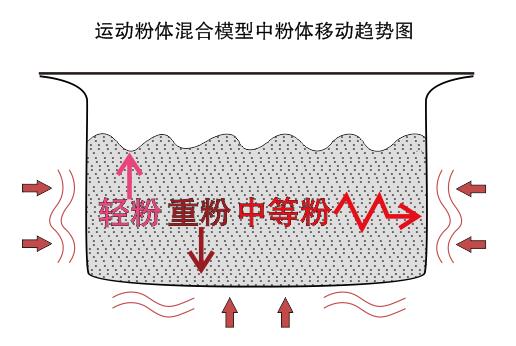1、 The Origin of Powder Mixing Model
Powder mixing itself is a very complex process, and research on powder mixing has always been carried out in a static state. Due to the diverse shapes, sizes, weights, and varieties of powder particles. The mixing process is carried out in the state of powder motion (i.e., the powder constantly undergoes displacement changes), so it is difficult to reflect the true form of mixing when studying powder mixing in a static state.
After years of research and analysis of thousands of powder types in various industries, the team of Zhengzhou Jinhe Company has observed that under intense external forces, the moving powder exhibits liquid like motion characteristics (powder can float, sink, suspend, and interact with viscosity). The more intense the external force is applied, the more obvious the liquid characteristics of the powder are. Given this characteristic, we have established a powder liquid mixing model to explain and analyze the dynamic characteristics of powder mixing, making the research on powder mixing clearer and easier.
2、 Definition of Liquid Mixing Model for Moving Powder
Definition: Under the action of external forces, the powder inside the container undergoes intense movement, and during the process of mixing and mixing between the powder particles in the moving powder, there is a characteristic of liquidization, which means that the powder particles will appear "floating up", "sinking", and "suspended" in the main powder due to their own factors. The motion mode of this powder is the liquid mixing model of the moving powder, as shown in the following figure.

3、 Connotation of Liquid Mixing Model for Sports Powder
1. The Movement Trend of Powder Particles in the Main Powder
According to the principle of liquid mixing model, there are the following motion trends
1) Under the same conditions, the powder particles are lighter, and their movement trend is upward, while the opposite is downward. The lighter the powder particles, the more obvious the upward trend is, which is less conducive to the process of uniform mixing;
2) Under the same conditions, if the powder particles are smaller, the movement trend is upward, and vice versa, it is downward. The smaller the powder particles, the more obvious the upward trend, which is less conducive to the process of uniform mixing;
3) The density and particle size of the powder particles are balanced, and the movement trend is in the middle suspended state, which is conducive to the process of uniform mixing.
2. What is the density of "liquid" in the liquid mixing model
The carrier of the liquid mixing model is the main powder, which is regarded as a "liquid", and its "liquid" density is the average density of the main powder. When the density of powder particles exceeds the density of "liquid", they sink.
The carrier of the liquid mixing model also has a "liquid" indicator, which is the average particle size of the main powder. When the particle size of the powder exceeds the particle size of the "liquid" (the main powder particle size), it sinks.
3. The more intense the powder movement, the more obvious the phenomenon of liquid transformation
Under the action of external forces, the more intense the movement of the powder, the faster the process of the oversized or undersized powder particles floating and sinking.
4. The better the fluidity of the main powder, the more obvious the phenomenon of liquidization
When the fluidity of the main powder participating in the mixing is better, the movement process of the oversized or undersized powder particles floating and sinking is faster.
4、 The significance of the liquid mixing model for sports powder
The liquid mixing model of sports powder provides a theoretical basis for studying powder mixing technology. Pointed out the direction for future powder mixing research:
1. It visually displays the movement trend of powder particles in the main powder, and also reveals the difficulty and reasons for uniform mixing between different powders.
2. To serve as a basis for guiding experiments in powder mixing and developing mixing processes.
3. This has laid a theoretical foundation for quantifying and deepening the analysis of powder mixing technology.
4. The liquid mixing model is the foundation of the alloy mixing index (detailed in Topic 19 of the Powder Mixing Encyclopedia), and has practical significance for accurately guiding powder mixing.
The Jinhe Mixing Index is our team's passionate dedication to the powder mixing industry, and careful reading will definitely yield rewards!